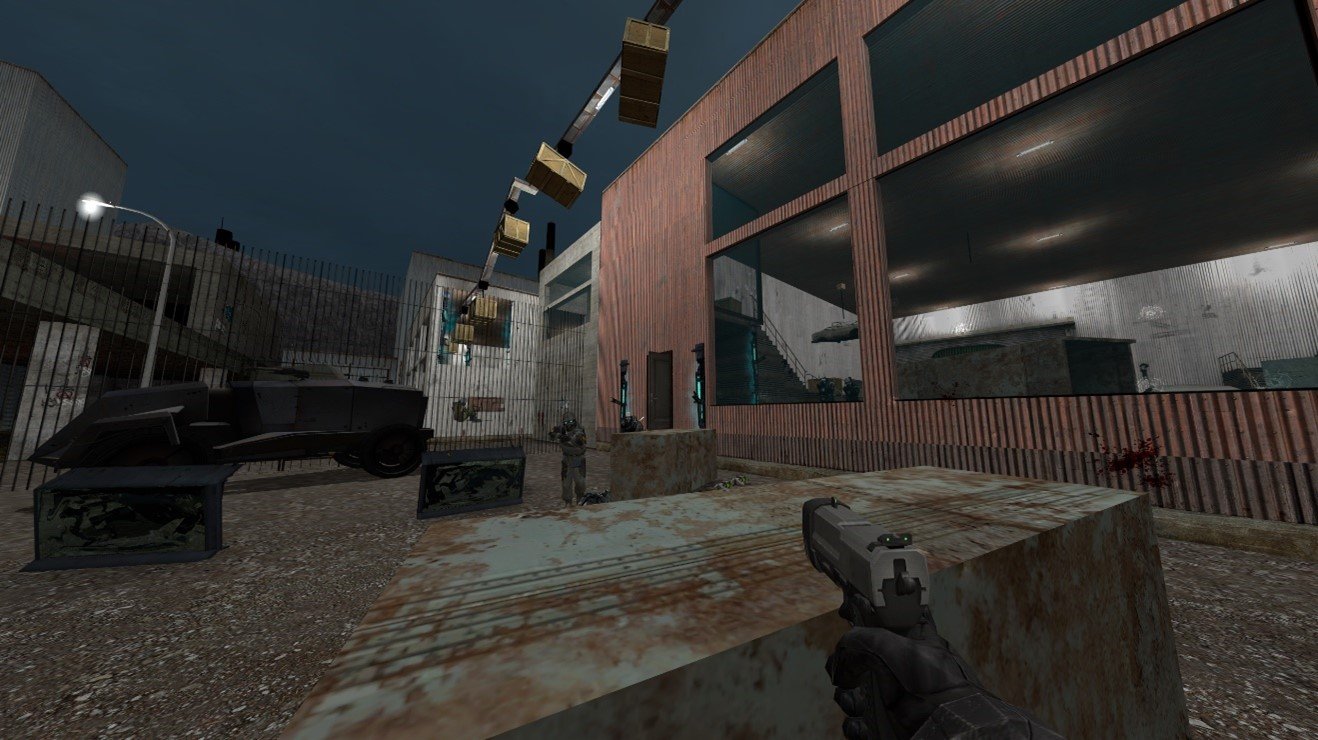
A Half-Life 2 Level
Factory Conspiracy
Factory Conspiracy is a single-player Half-Life 2 level that creatively utilizes a unique conveyor belt mechanic, influencing both combat and puzzle-solving throughout the level. The playthrough lasts approximately 8 minutes and features four main combat areas, including both indoor and outdoor battles, offering a distinctive experience. The level was designed and developed solo over the course of approximately 120 hours.
Playthrough Video
Goal
For example, in this outdoor scene, players encounter a massive container suspended from a crane. Earlier in the level, players learned that ropes can be shot to drop objects. When the player shoots the rope, the large container crashes down, breaking the bridge and falling into the water, creating a path to cross the river. This cleverly utilizes the large object as a landmark, providing a memorable "wow moment" as the container plunges into the river. Players must then reuse the wooden crates from earlier as stepping stones to climb onto the container and continue their journey.
This is the player’s starting perspective, offering a clear overview of the entire level from the beginning. The player’s goal is also immediately apparent: find a way to reach the car on the opposite side and escape. Several guiding elements are utilized here, such as the red taillights of the car to draw the player’s attention. The door next to the car features a green light, indicating it as a passable route, while the tunnel is illuminated with lights and marked with signs on the wall, pointing to the right as the way out.
Additionally, the crane is visible from this position, serving as an excellent landmark due to its massive size and its visibility from almost anywhere in the level. The green lights on the crane cast a glow onto the opposite building, emphasizing the building's importance and subtly encouraging players to look upward. This highlights the hanging container, hinting that it can be knocked down later, setting up an essential puzzle mechanic for subsequent gameplay.
When the player enters the building and completes the combat, they can once again see the opposite room through a glass window. A gap below the warehouse door provides a glimpse of their goal, along with a staircase leading down, suggesting that the player needs to find a path upstairs to access the opposite room. This design ensures the player has a clear understanding of their objective.
Through the carefully designed factory theme, I aimed to give players the immersive experience of escaping the factory alone. The level showcases numerous factory-related elements, such as containers, cranes, and wooden crates, to reinforce the setting. During gameplay, players can utilize moving wooden crates on conveyor belts and various hanging objects as dynamic cover options. For instance, a hanging truck serves as a large, robust cover, while wooden crates offer temporary protection. Additionally, these wooden crates are integral to puzzle-solving, acting as stepping stones for players to build makeshift staircases and navigate the environment.
In the design, I also focused on the reusability of resources, aiming to give players a sense of familiarity with previously encountered areas or objects during combat and exploration. For instance, in the battle shown in the image, enemies emerge from a previously visited combat room to attack the player outdoors. This design offers players a chance to anticipate upcoming events based on earlier encounters, while also providing a distinctly different combat experience in the same environment.
Design
While exploring the conveyor belt mechanic, I invested significant effort into implementing this technology. The initial idea behind the conveyor belt was to allow players to use special physical objects, such as crates, as part of both combat and puzzles in the map. However, I realized that if players destroyed or lost these objects, it could become challenging for them to progress, potentially leading to showstoppers. To address this, I aimed to design a system that provided players with unlimited resources while incorporating a penalty for overuse.
I leveraged Hammer's train track functionality to create the conveyor belt. Essentially, this system operates as a train track but was cleverly adapted into a conveyor belt using Hammer’s features. This mechanic ensures players always have access to resources—if they break the available crates, they must wait for new ones to arrive, introducing a time penalty. Additionally, enemies can also destroy these crates, further reducing the players’ opportunities to use them and increasing the challenge.
This is another perspective, showing what the player sees after reaching the opposite side of the river. Here, the player can clearly view their final goal, the back of the car, ensuring they always have a sense of direction and positioning. However, the player is confronted with a fence, signaling that the direct path is blocked. This prompts them to enter the building and figure out an alternative way to reach the car.












